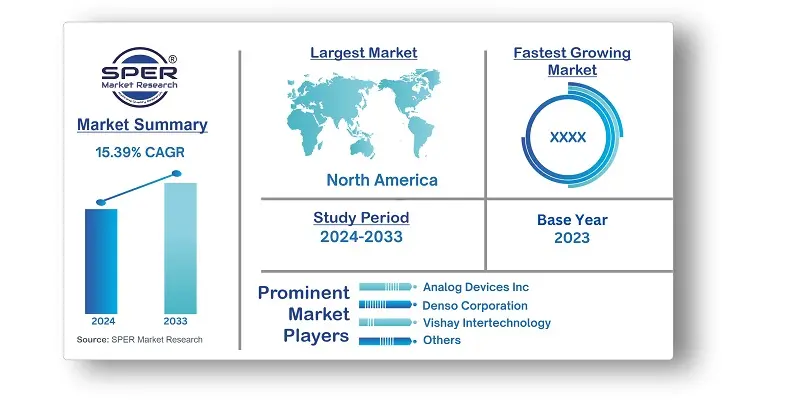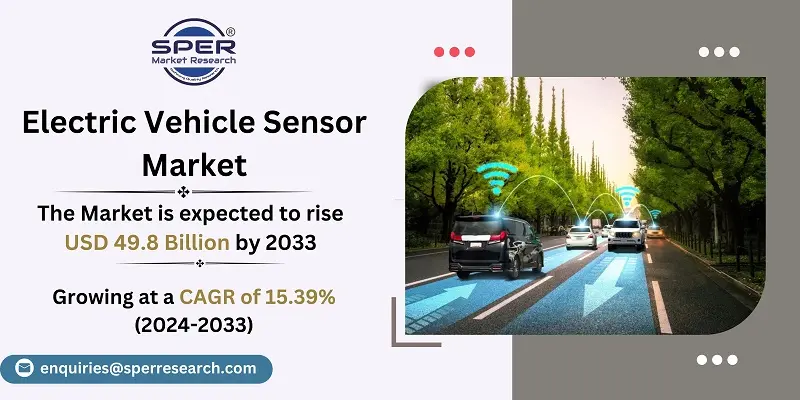
Electric Vehicle Sensor Market Growth, Size, Trends, Demand, Share, Revenue and Future Outlook
Electric Vehicle Sensor Market Size- By Product Type, By Vehicle Type, By Propulsion, By Sales Channel- Regional Outlook, Competitive Strategies and Segment Forecast to 2033
| Published: Apr-2024 | Report ID: AMIN24109 | Pages: 1 - 205 | Formats*: |
| Category : Automotive & Transportation | |||
- Infineon introduced the Xensiv TLI5590-A6W magnetic position sensor in January of 2024. The tiny size of the sensor is its main advantage over conventional position sensors.
- Continental released the eRPS sensor in February 2023. The sensor claims to give operations a high degree of accuracy.


| Report Metric | Details |
| Market size available for years | 2020-2033 |
| Base year considered | 2023 |
| Forecast period | 2024-2033 |
| Segments covered | By Product Type, By Vehicle Type, By Propulsion, By Sales Channel |
| Regions covered | North America, Asia-Pacific, Latin America, Middle East & Africa and Europe |
| Companies Covered | Analog Devices Inc., Denso Corporation, Amphenol Advanced Sensors, NXP Semiconductors NV, Vishay Intertechnology, Inc, Texas Instruments Incorporated, AMS Osram AG, Infineon Technologies AG, Allegro MicroSystems, LLC, Melexis, STMicroelectronics, Sensata Technologies, and Renesas Electronics Corporation. |
- Automotive Manufacturers
- Sensor Manufacturers
- Technology Suppliers
- Research Institutions
- Government Organization
| By Product Type: |
|
| By Vehicle Type: |
|
| By Propulsion: |
|
| By Sales Channel: |
|
- Global Electric Vehicle Sensor Market Size (FY’2024-FY’2033)
- Overview of Global Electric Vehicle Sensor Market
- Segmentation of Global Electric Vehicle Sensor Market By Product Type (Temperature Sensor, Motion Sensor, Pressure Sensor, Gas Sensor, Speed Sensor, Others)
- Segmentation of Global Electric Vehicle Sensor Market By Vehicle Type (Passenger Cars, Commercial Vehicles, Others)
- Segmentation of Global Electric Vehicle Sensor Market By Propulsion (Hybrid Electric Vehicles, Plug-In Hybrid Electric Vehicles, Battery Electric Vehicles, Others)
- Segmentation of Global Electric Vehicle Sensor Market By Sales Channel (OEM, Aftermarket, Others)
- Statistical Snap of Global Electric Vehicle Sensor Market
- Expansion Analysis of Global Electric Vehicle Sensor Market
- Problems and Obstacles in Global Electric Vehicle Sensor Market
- Competitive Landscape in the Global Electric Vehicle Sensor Market
- Impact of COVID-19 and Demonetization on Global Electric Vehicle Sensor Market
- Details on Current Investment in Global Electric Vehicle Sensor Market
- Competitive Analysis of Global Electric Vehicle Sensor Market
- Prominent Players in the Global Electric Vehicle Sensor Market
- SWOT Analysis of Global Electric Vehicle Sensor Market
- Global Electric Vehicle Sensor Market Future Outlook and Projections (FY’2024-FY’2033)
- Recommendations from Analyst
1.1. Scope of the report1.2. Market segment analysis
2.1. Research data source2.1.1. Secondary Data2.1.2. Primary Data2.1.3. SPER’s internal database2.1.4. Premium insight from KOL’s2.2. Market size estimation2.2.1. Top-down and Bottom-up approach
2.3. Data triangulation
4.1. Driver, Restraint, Opportunity and Challenges analysis4.1.1. Drivers4.1.2. Restraints4.1.3. Opportunities4.1.4. Challenges4.2. COVID-19 Impacts of the Global Electric Vehicle Sensor Market
5.1. SWOT Analysis5.1.1. Strengths5.1.2. Weaknesses5.1.3. Opportunities5.1.4. Threats5.2. PESTEL Analysis5.2.1. Political Landscape5.2.2. Economic Landscape5.2.3. Social Landscape5.2.4. Technological Landscape5.2.5. Environmental Landscape5.2.6. Legal Landscape5.3. PORTER’s Five Forces5.3.1. Bargaining power of suppliers5.3.2. Bargaining power of buyers5.3.3. Threat of Substitute5.3.4. Threat of new entrant5.3.5. Competitive rivalry5.4. Heat Map Analysis
6.1. Global Electric Vehicle Sensor Market Manufacturing Base Distribution, Sales Area, Ingredients6.2. Mergers & Acquisitions, Partnerships, Product Launch, and Collaboration in Global Electric Vehicle Sensor Market
7.1. Global Electric Vehicle Sensor Market Value Share and Forecast, By Product Type 2024-20337.2. Temperature Sensor7.3. Motion Sensor7.4. Pressure Sensor7.5. Gas Sensor7.6. Speed Sensor7.7. Others
8.1. Global Electric Vehicle Sensor Market Value Share and Forecast, By Vehicle Type 2024-20338.2. Passenger Cars8.3. Commercial Vehicles8.4. Others
9.1. Global Electric Vehicle Sensor Market Size Value Share and Forecast, By Propulsion 2024-20339.2. Hybrid Electric Vehicles (HEVs)9.3. Plug-In Hybrid Electric Vehicles (PHEVs)9.4. Battery Electric Vehicles (BEVs)9.5. Others
10.1. Global Electric Vehicle Sensor Market Size Value Share and Forecast, By Sales Channel 2024-203310.2. OEM10.3. Aftermarket10.4. Others
11.1. Global Electric Vehicle Sensor Market Size and Market Share
12.1. Global Electric Vehicle Sensor Market Size and Market Share, By Product Type (2020-2026)12.2. Global Electric Vehicle Sensor Market Size and Market Share, By Product Type (2027-2033)
13.1. Global Electric Vehicle Sensor Market Size and Market Share, By Vehicle Type (2020-2026)13.2. Global Electric Vehicle Sensor Market Size and Market Share, By Vehicle Type (2027-2033)
14.1. Global Electric Vehicle Sensor Market Size and Market Share, By Propulsion (2020-2026)14.2. Global Electric Vehicle Sensor Market Size and Market Share, By Propulsion (2027-2033)
15.1. Global Electric Vehicle Sensor Market Size and Market Share, By Sales Channel (2020-2026)15.2. Global Electric Vehicle Sensor Market Size and Market Share, By Sales Channel (2027-2033)
16.1. Global Electric Vehicle Sensor Market Size and Market Share, By Region (2020-2026)16.2. Global Electric Vehicle Sensor Market Size and Market Share, By Region (2027-2033)16.3. Asia-Pacific16.3.1. Australia16.3.2. China16.3.3. India16.3.4. Japan16.3.5. South Korea16.3.6. Rest of Asia-Pacific16.4. Europe16.4.1. France16.4.2. Germany16.4.3. Italy16.4.4. Spain16.4.5. United Kingdom16.4.6. Rest of Europe16.5. Middle East and Africa16.5.1. Kingdom of Saudi Arabia16.5.2. United Arab Emirates16.5.3. Rest of Middle East & Africa16.6. North America16.6.1. Canada16.6.2. Mexico16.6.3. United States16.7. Latin America16.7.1. Argentina16.7.2. Brazil16.7.3. Rest of Latin America
17.1. Analog Devices Inc.17.1.1. Company details17.1.2. Financial outlook17.1.3. Product summary17.1.4. Recent developments17.2. Denso Corporation17.2.1. Company details17.2.2. Financial outlook17.2.3. Product summary17.2.4. Recent developments17.3. Amphenol Advanced Sensors17.3.1. Company details17.3.2. Financial outlook17.3.3. Product summary17.3.4. Recent developments17.4. NXP Semiconductors NV17.4.1. Company details17.4.2. Financial outlook17.4.3. Product summary17.4.4. Recent developments17.5. Vishay Intertechnology, Inc17.5.1. Company details17.5.2. Financial outlook17.5.3. Product summary17.5.4. Recent developments17.6. Texas Instruments Incorporated17.6.1. Company details17.6.2. Financial outlook17.6.3. Product summary17.6.4. Recent developments17.7. AMS Osram AG17.7.1. Company details17.7.2. Financial outlook17.7.3. Product summary17.7.4. Recent developments17.8. Infineon Technologies AG17.8.1. Company details17.8.2. Financial outlook17.8.3. Product summary17.8.4. Recent developments17.9. Allegro MicroSystems, LLC17.9.1. Company details17.9.2. Financial outlook17.9.3. Product summary17.9.4. Recent developments17.10. Melexis17.10.1. Company details17.10.2. Financial outlook17.10.3. Product summary17.10.4. Recent developments17.11. STMicroelectronics17.11.1. Company details17.11.2. Financial outlook17.11.3. Product summary17.11.4. Recent developments17.12. Sensata Technologies17.12.1. Company details17.12.2. Financial outlook17.12.3. Product summary17.12.4. Recent developments17.13. Renesas Electronics Corporation17.13.1. Company details17.13.2. Financial outlook17.13.3. Product summary17.13.4. Recent developments17.14. Others
SPER Market Research’s methodology uses great emphasis on primary research to ensure that the market intelligence insights are up to date, reliable and accurate. Primary interviews are done with players involved in each phase of a supply chain to analyze the market forecasting. The secondary research method is used to help you fully understand how the future markets and the spending patterns look likes.
The report is based on in-depth qualitative and quantitative analysis of the Product Market. The quantitative analysis involves the application of various projection and sampling techniques. The qualitative analysis involves primary interviews, surveys, and vendor briefings. The data gathered as a result of these processes are validated through experts opinion. Our research methodology entails an ideal mixture of primary and secondary initiatives.



Frequently Asked Questions About This Report
PLACE AN ORDER
Year End Discount
Sample Report
Pre-Purchase Inquiry
NEED CUSTOMIZATION?
Request CustomizationCALL OR EMAIL US
100% Secure Payment






Related Reports
Our Global Clients
Our data-driven insights have influenced the strategy of 200+ reputed companies across the globe.




















